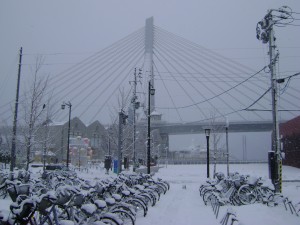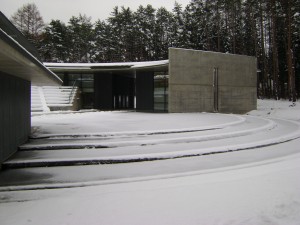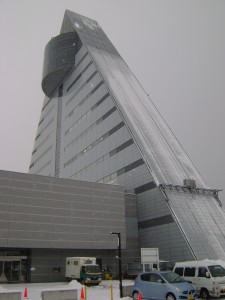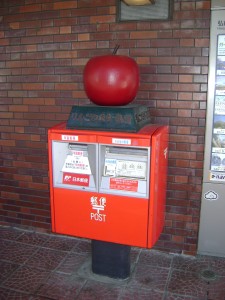by Ian Rogers
Apples are grown in Aomori, my ESL textbook says. Drop the agent, use the past participle, and swap the subject for the object to form the passive. Growers raise eels in Hamamatsu becomes Eels are raised in Hamamatsu. So too with Tokyo Tower was built in 1958 and Rice is grown in Niigata. Grown, not cultivated, I say. Japanese students always want to say cultivated.
I came to Aomori to be alone, away from English classrooms and forced conversations and wrinkle-free dress shirts, past Fukushima and the power plant not yet spiraled into meltdown, past Sendai and one-eyed Masamune’s statue, and past the Morioka iron works to Japan’s northern tip, last stop before Hakodate. My goal is the Aomori Contemporary Art Center, designed by Tadao Ando, an architect whose buildings on Naoshima rise from the hills, their doors and roofs merged seamlessly with the island’s landscape. Now I want to see Ando’s ACAC. It’s best not to think too much when traveling, just pick a destination and go. Better to move constantly than stand still.
Aomori Prefecture, like Hyogo and Yamaguchi, touches both the Pacific Ocean and the Sea of Japan, though only Hyogo is worth noting because Aomori and Yamaguchi form the ends of Honshu, Japan’s main island. I’m riding on a seven-day Hokkaido and East Japan winter rail pass to save money, and this far north you wait an hour for the JR connections at the smaller stations. In Odate I wander snow-covered streets past rusted-out beauty parlors and old electronics shops, remnants of Japan’s boom in the 1980s. People nod in greeting as I pass, and some say hello as they clear away piles of wet snow. Back at the station when darkness falls and the people huddle in thick jackets on the platform, I catch the Ou line train and take two seats to myself, since there’s room to spare as we pass into Aomori.
Just before my visit, Japan Railway unveiled the Aomori bullet train, opening Honshu’s northern regions to new generations of tourists. Three and a half hours from Tokyo to Aomori! Explore your country, your land, your heritage! Commercials show clear-skinned actors grabbing red-green apples from drooping branches in the sunshine, the train line always in the background. My First Aomori, the commercials say. Apples are grown in Aomori, and the people who grow them are invisible.
They say the Aomori dialect is difficult to understand, moreso even than old people in Yamanashi. They say the people learned to speak muffled sentences in cold weather with their mouths closed, but no one knows for sure because no one visits Aomori. Most people just fly to Sapporo where you can eat the freshest salmon you’ve ever tasted, take your picture in front of the clock tower, and see the snow festival in February. Sapporo is famous. Aomori isn’t, but everyone knows that apples are grown there.
In Aomori City the snowflakes fall hard, twirling against the streetlights, but people walk and drive by without noticing, familiar already with the fruit-filled streets outside the train station. Here, venders sell round apples from oversized crates, a plaster apple tops a red mailbox, and a store’s front sign reads Apple Shop in friendly English. The apples are all expensive, specialty fruit, obligatory tourist gifts for acquaintances and coworkers. I don’t buy any apples, but I do buy a plate of enormous sushi pieces from an empty shop run by an elderly couple startled to see me. I eat at the counter, staring alone at the Japanese signs on the wood-paneled walls. The hotate—scallop—is the best, better than any in Japan, my students tell me, so I order some and find they’re right. If the hotate is so good, why doesn’t JR show it on the commercials?
From my hotel window I watch the Aomori Bay Bridge, long and high with red beacons that flash to warn planes. Multicolored spotlights shine on its towers, their greens and yellows eerie in the snowy night. I gaze out at the bridge until I realize it spans a small bay easily bypassed by a street running along the shoreline. Few cars cross the bridge; it can’t save more than five minutes drive time. From the window I reflect on the bridge’s uselessness but admire its beauty anyway.
There’s also an enormous pyramid by the harbor reminiscent of the Tyrell building in Blade Runner, except this one’s a tourist information center with a top-floor observation deck. Like the bridge, it’s out of place, newer than the worn-out docks and concrete walls separating land from ocean. I wander by the pyramid and watch the snowflakes disappear in the sea’s blackness; here the docks extend into the water and my feet sink into the snow. The pyramid is open but there’s no one here.
I ride a bus to the ACAC, and after a few stops I’m the only one still on. Outside the complex I tell the driver Arigato and walk the path through the still-falling snow. The Aomori Contemporary Art Center is a museum and studio where visiting artists come to work in the serenity of the Tohoku forest; the museum wraps a half-circle around a clearing with tall tunnels joining interior with exterior, their undersides untouched by the snow piling up outside. The museum’s open for the New Year season, but when the smiling attendant bows and hands me my ticket, I find I’m one of only two people there. There’s art everywhere in the gallery, crammed into this tiny space of a half-circle, every piece different, nothing the same. Would more people come if the JR commercials showed the ACAC instead of apples?
In the evening I ride the bus back to the station, where it’s windier and darker now that the snow’s let up. I drink hot cider in a café where I sit alone and the staff works busily, unseen in a back room. The café has the mass-market appeal of a Japanese chain, whereas the sushi shop was old and family-run, though one is as empty as the other. The streets feel deserted under uncleared snow, and I watch mannequin displays in windows while few cars drive behind me on the snowy streets. The venders too, have gone home, and there are no more apples left to buy.
The Aomori Bay Bridge stands as powerfully as ever outside my hotel, and from my window I watch its unused lanes, black under the colored tower spotlights. Japan built this bridge, I’m certain now, because they needed something to build, like the Aomori bullet train and the harbor pyramid, to bring people north and breathe life into this silent place, and to prove again that there are still great feats to accomplish. When Alexander reached the edge of the world he wept. . . . The country wants to expand, but they’ve already reached the edge. Is Aomori a frontier, or a parody no one wants to conquer? The ones who’ve lived here the longest remember when it all was new, and when they’ve gone I wonder who will serve the cider and tear the tickets at the ACAC. Aomori then will become its own agentless passive, existing on the page but absent from people’s experience. That’s why the JR actors all smile in the commercials and the colored towers glow like Arctic skies in the night.
When the edge of the world has been explored and abandoned, how then will we try to make it new? What lies will we tell ourselves, and when these too fade away, what then will we remember about the time when it really was?
Apples are grown in Aomori.





